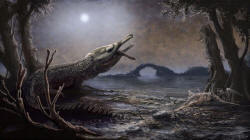|
 Crocodile
rock: ancient beast named after Motörhead band's Lemmy Crocodile
rock: ancient beast named after Motörhead band's Lemmy
 Send a link to a friend
Send a link to a friend
[August 10, 2017]
By Will Dunham
WASHINGTON (Reuters) - A
ferocious sea-going crocodile that menaced coastal
waters about 164 million years ago during the Jurassic
Period has been given a name honoring the similarly
ferocious heavy-metal rocker Lemmy, the late front man
for the British band Motörhead.
|
|
 Scientists said on Wednesday they have named
the 19-foot-long (5.8 meters) reptile Lemmysuchus, meaning "Lemmy's
crocodile." Its fossils were unearthed near the eastern English
city of Peterborough in 1909 and were recently re-examined and
determined to be a distinct genus in need of a name. Scientists said on Wednesday they have named
the 19-foot-long (5.8 meters) reptile Lemmysuchus, meaning "Lemmy's
crocodile." Its fossils were unearthed near the eastern English
city of Peterborough in 1909 and were recently re-examined and
determined to be a distinct genus in need of a name.
Its enlongated, narrow snout resembled those of modern
fish-eating crocs from India called gharials. It boasted large,
blunt teeth perfect for crushing turtle shells or other
hard-bodied prey like hard-scaled fish, said University of
Edinburgh paleontologist Michela Johnson, lead author of the
study published in the Zoological Journal of the Linnean
Society.

"It's big, ugly and quite scary. We think that Lemmy would have
liked it. For me, this is a career high, and I can now die
happy," added another of the researchers, Lorna Steel, who came
up with the name.
Known for hard living and hard rocking, gravelly voiced Ian "Lemmy"
Kilmister, died of cancer at age 70 in 2015 in Los Angeles. He
formed his influential band Motörhead in 1975.
"I wanted to name something after Lemmy after he died," said
Steel, senior curator for fossils from the croc family, birds
and flying reptiles at the Natural History Museum in London.
[to top of second column] |

"At that time, late December 2015, I was working with colleagues
from Edinburgh University on this particular fossil specimen. I kept
the thought to myself for a while but then floated the idea past the
others. They all thought it was great and it really is the most
appropriate fossil to bear Lemmy's name."
Lemmysuchus was a member of a group called teleosaurs, sea-going
crocodiles that thrived for tens of millions of years during the age
of dinosaurs. The seas at the time were also populated by a number
of types of marine reptiles including long-necked plesiosaurs and
dolphin-like ichthyosaurs.
Johnson studied the fossil specimen held at the Natural History
Museum and determined that it had been incorrectly classified as
another teleosaur called Steneosaurus.
(Reporting by Will Dunham; Editing by Sandra Maler)
[© 2017 Thomson Reuters. All rights
reserved.] Copyright 2017 Reuters. All rights reserved. This material may not be published,
broadcast, rewritten or redistributed.
 |